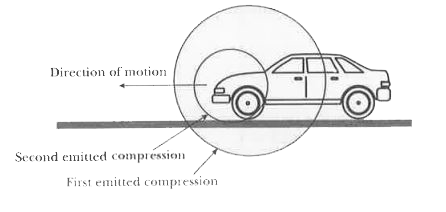Complete Solutions to PRACTICE QUESTIONS (LINKED COMPREHENSION) of chapter WAVE - II of Class 12 book with complete answers and questions
| Class 12 | PHYSICS |
| Chapter | WAVE - II |
| RESNICK AND HALLIDAY | PRACTICE QUESTIONS (LINKED COMPREHENSION) |
| Number Of Questions | 11 |
| Academic Year | 2023-24 |
The diagram shows the various positions of a child in motion on a swing. Somewhere in front of the child a stationary whistle is blowing.

At which position(s) will the child hear the highest frequency for the sound from the whistle?
View SolutionThe diagram shows the various positions of a child in motion on a swing. Somewhere in front of the child a stationary whistle is blowing.

At which position(s) will the child hear the lowest frequency for the sound from the whistle?
View SolutionThe diagram shows the various positions of a child in motion on a swing. Somewhere in front of the child a stationary whistle is blowing.

At which position(s) will the child hear the same frequency as that heard by a stationary observer standing next to the whistle?
View SolutionThe car in the figure is moving to the left at 35 m/s. The car's horn continuously emits a `2.20 xx 10^2` Hz sound. The figure also shows the first two regions of compression of the emitted sound waves. The speed of sound is 343 m/s.

How far does the car move in one period of the sound emitted from the horn?
View SolutionThe car in the figure is moving to the left at 35 m/s. The car's horn continuously emits a `2.20 xx 10^2` Hz sound. The figure also shows the first two regions of compression of the emitted sound waves. The speed of sound is 343 m/s.

How far has the initial compression traveled when the second compression is emitted?
View SolutionThe car in the figure is moving to the left at 35 m/s. The car's horn continuously emits a `2.20 xx 10^2` Hz sound. The figure also shows the first two regions of compression of the emitted sound waves. The speed of sound is 343 m/s.

What is the wavelength of the sound in the direction of motion of the car?
View SolutionThe car in the figure is moving to the left at 35 m/s. The car's horn continuously emits a `2.20 xx 10^2` Hz sound. The figure also shows the first two regions of compression of the emitted sound waves. The speed of sound is 343 m/s.

What is the frequency heard by a stationary observer standing in front of the car?
View SolutionTwo loudspeakers are located 3 m apart on the stage of an auditorium. A listener at point P is seated 29.0 m from one speaker and 25.0 m from the other. A signal generator drives the speakers in phase with the same amplitude and frequency. The wave amplitude at P due to each speaker alone is A. The frequency is then varied between 20 Hz and 300 Hz. The speed of sound is 343 m/s.
At what frequency or frequencies will the listener at P hear a maximum intensity?
View SolutionTwo loudspeakers are located 3 m apart on the stage of an auditorium. A listener at point P is seated 29.0 m from one speaker and 25.0 m from the other. A signal generator drives the speakers in phase with the same amplitude and frequency. The wave amplitude at P due to each speaker alone is A. The frequency is then varied between 20 Hz and 300 Hz. The speed of sound is 343 m/s.
Determine the value of the maximum amplitude in terms of A.
View SolutionVibrations with frequency `6.00 xx 10^2` Hz are established on a 1.33 m length of string that is clamed at both ends. The speed of waves on the string is `4.0 xx 10^2 m//s`
How many antinodes are contained in the resulting standing wave pattern?
View SolutionVibrations with frequency `6.00 xx 10^2` Hz are established on a 1.33 m length of string that is clamed at both ends. The speed of waves on the string is `4.0 xx 10^2 m//s`
How far from either end of the string does the first node occur?
View Solution
PRACTICE QUESTIONS (LINKED COMPREHENSION) questions and complete solutions for chapter WAVE - II of RESNICK AND HALLIDAY PHYSICS (HINGLISH) of Class 12